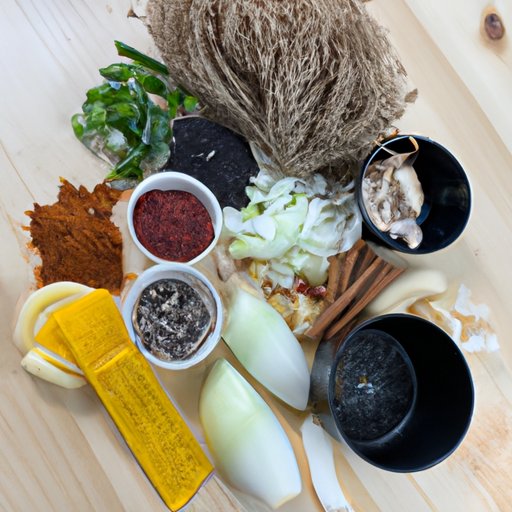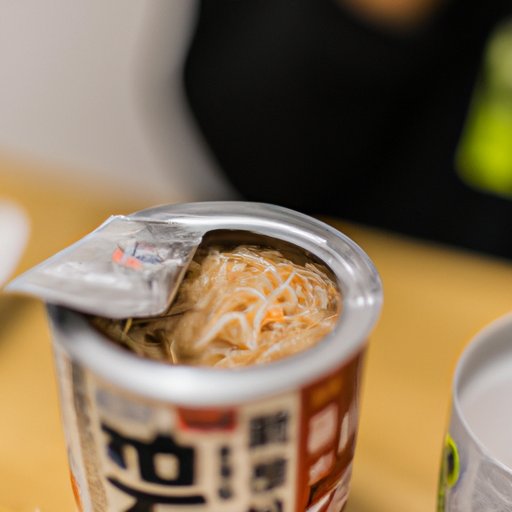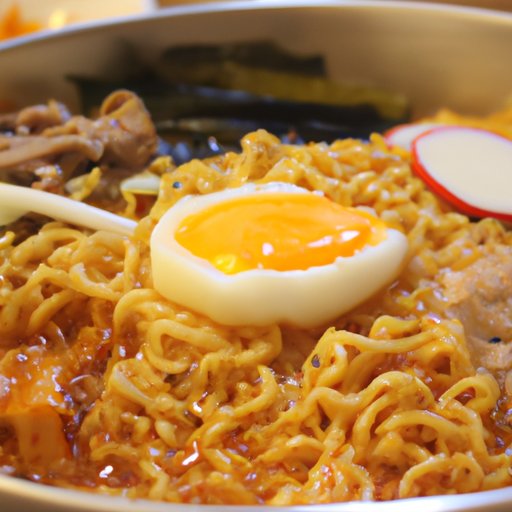Introduction
Korean ramen is a type of noodle dish that has become increasingly popular in recent years. It typically consists of wheat noodles served in a broth flavored with various spices, herbs, and vegetables. While Korean ramen can be a tasty and convenient meal choice, it is important to consider its nutritional value when determining if it is a healthy option. This article will explore the various components of Korean ramen, including the macronutrients, traditional spices and herbs, sodium content, processed foods, and homemade alternatives, in order to determine if it is a healthy food choice.

Analyzing the Macronutrients in Korean Ramen and Exploring its Health Benefits
The primary macronutrients found in Korean ramen are carbohydrates, protein, and fat. Carbohydrates provide energy and help to keep the body fueled, while proteins and fats are essential for growth and development. Consuming a balanced diet that includes all three macronutrients is important for overall health and wellbeing.
In terms of health benefits, consuming Korean ramen can provide essential vitamins and minerals that are important for maintaining health. For example, some varieties of Korean ramen contain high levels of B vitamins, which play an important role in energy production, as well as iron, which helps to support red blood cell formation. Additionally, Korean ramen can provide dietary fiber, which is important for digestion and regularity.

Exploring the Role of Traditional Korean Spices and Herbs in Making Healthy Ramen
Korean ramen often features a variety of traditional spices and herbs that can add flavor and nutrition to the dish. Commonly used ingredients include garlic, ginger, and chilies, which have been found to have anti-inflammatory properties, as well as turmeric, which has been linked to a range of health benefits, including improved digestion and heart health. In addition, many traditional Korean dishes feature kimchi, which is a fermented vegetable side dish that is packed with probiotics, which can help to improve gut health.
Using these types of spices and herbs can help to make Korean ramen a healthier dish by increasing its nutrient content and providing additional health benefits. Additionally, they can help to reduce the need for added salt and sugar, which can reduce the amount of sodium and sugar consumed.

Examining the Sodium Content of Popular Korean Ramen Brands
Sodium is an important mineral that is necessary for maintaining fluid balance in the body. However, too much sodium can lead to hypertension and other health problems. Many popular brands of Korean ramen contain high levels of sodium, with some containing over 1,000 mg per serving. It is important to be aware of the sodium content of different brands and choose those that contain lower amounts. Additionally, it is possible to reduce the sodium content of Korean ramen by using low-sodium ingredients and avoiding adding extra salt.
Investigating the Use of Processed Foods in Korean Ramen
Many store-bought varieties of Korean ramen contain processed ingredients, such as canned vegetables and pre-packaged sauces. While these ingredients can provide convenience, they can also be high in sodium, sugar, and unhealthy fats. Additionally, some processed foods may contain preservatives and other additives that can be harmful to health. Therefore, it is important to read labels carefully and choose products that contain fewer processed ingredients.
Comparing the Nutritional Value of Homemade vs. Store-Bought Korean Ramen
Making Korean ramen at home is one way to ensure that you are consuming a healthier version of the dish. When making ramen at home, it is possible to control the ingredients and use fresh, whole foods instead of processed ones. Additionally, homemade ramen can be tailored to individual tastes and dietary needs, allowing for greater flexibility when creating a nutritious and delicious dish.
Conclusion
In conclusion, Korean ramen can be a healthy food choice if it is made with the right ingredients and prepared in a nutritious way. By understanding the macronutrients, traditional spices and herbs, sodium content, processed ingredients, and homemade alternatives, it is possible to make informed decisions about how to consume Korean ramen in a healthy way. Ultimately, it is important to be mindful of what goes into your ramen and strive for a balance of flavors and nutrition.
To sum up, Korean ramen can be a healthy and enjoyable meal if it is prepared with fresh, whole foods and the right balance of spices and herbs. Additionally, it is important to consider the sodium content of different brands and limit the amount of processed ingredients. Finally, making homemade ramen is an easy and nutritious alternative to store-bought versions.
Recommendations for Healthy Ramen Consumption
When it comes to eating Korean ramen in a healthy way, there are several strategies that can be employed. First, it is important to choose brands that contain lower amounts of sodium. Additionally, opt for fresh, whole ingredients whenever possible and avoid processed foods. Finally, consider making your own ramen at home, as this allows for greater control over the ingredients and flavors.
(Note: Is this article not meeting your expectations? Do you have knowledge or insights to share? Unlock new opportunities and expand your reach by joining our authors team. Click Registration to join us and share your expertise with our readers.)
